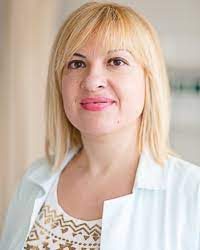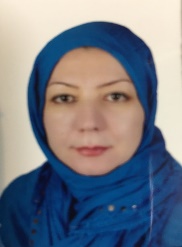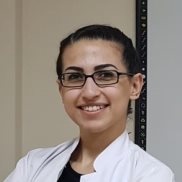Day :
- Cognitive Neuroscience | Neurology | Neuropsychiatry | Neurogenetic and Neurometabolic Disorders | Clinical Neurology and Neurosurgery | Child Health and Psychology | Educational Psychology | Child and Adolescent Counselling Psychology | Neuropharmacology and Neurogenetics
Location: Webinar
Session Introduction
Kalliopi Megari
Aristotle University of Thessaloniki, Greece
Title: Brain & neurocognitive functions of COVID-19 patients

Biography:
Kalliopi Megari is an experienced psychologist working in the hospital & health care industry. She is a lecturer at University of Western Macedonia in Greece. Skilled in Clinical Neuropsychology, Clinical Research and Learning Disabilities. Graduated from Aristotle University of Thessaloniki and attended further education from University of Macedonia, in people with special needs and disabilities. She holds undergraduate degrees in Nursing and Psychology, as well as a Master’s and a PhD in Neuropsychology from Aristotle University of Thessaloniki. She has many years of experience working with chronic disease patients as well with people with disabilities. Her work has earned her many prestigious international awards. She has given lectures at Aristotle University of Thessaloniki and University of Warsaw. She is postdoctoral researcher and has published more than 10 research articles in journals. She is the Global Engagement Representative of International Neuropsychological Society and member of the Ethics Committee of Hellenic Neuropsychological Society.
Abstract:
A novel coronavirus (SARS-CoV-2) currently led to previously unknown COVID-19 pandemic. The clinical profile of COVID-19 infection, ranges from asymptomatic infection to severe pneumonia, Acute Respiratory Distress Syndrome (ARDS) and/or subsequent multiorgan failure, myalgia and fatigue. In addition to the lungs, COVID-19 may cause damage to many systems such as the heart, the kidneys, the liver, and the brain, as well as blood and the immune system. Studies describe patients that suffer from acute Central Nervous system Symptoms (CNS) in individuals affected by COVID-19 such as inflammatory CNS syndromes encephalitis, cerebrovascular or confusion/altered mental state, headache, dizziness, impaired consciousness, ataxia, acute cerebrovascular disease and epilepsy, sensory-related symptoms hypogeusia, hyposmia. It is reported by studies that course of the infection is mild or asymptomatic in about 80–90% of cases. Symptoms from CNS are more common in older patients and those who have more underlying medical diseases with vascular risk factors, such as hypertension, diabetes or obesity hypertension and to be less likely to show the most typical symptoms, such as fever and dry cough. These variety of symptoms have an important social impact on patients, families, health care professionals and society. It is important that healthcare costs to be reduced leading to recovered patients’ optimal neurocognitive functioning. Permanent cognitive dysfunction influences independent living. Cognitive decline is an important problem for the patient and family, and also for the community. It causes major financial burden of medical costs to the family and health services and impacts independent living and daily activities of patients. Keywords: Brain, COVID-19, Cognitive Functioning, Neurological, Patients.
Rozita Aboutorabi
Ferdowsi University of Mashhad, Iran
Title: Metacognition: An hermeneutical phenomenology & neurology approach

Biography:
Rozita Aboutorabi has her expertise in Educational Philosophy and passion for Hermeneutical Phenomenology. Her open and contextual educational model based on Heidegger’s viewpoint about human beings and his understanding of the surrounded world in “Being & Time” creates new pathways for improving education. She has built this model after years of experience in research, teaching and philosophizing in the educational implications on Heidegger’s view. She is enthusiastic about neuroscience and she is doing research on metacognition as well. She is a hard-working persistent researcher who has a very exact plan for every step of the way and is strict on sticking to them. She discloses the overlaps of these two fields. This approach is responsive to all stakeholders and has a different way of focusing. Hope that the results of this research can lead to changes in educational fields and give them new insights to bring up humanity.
Abstract:
The current paper discloses the overlap of hermeneutical phenomenology and neurology. It is comparative analytical research. The human being (Dasein) in Heidegger’s viewpoint is temporal. As Dasein according to past possibilities, in the present he projects himself in the future. In fact, our life experiences open possibilities to us to understand what can I do and who I will be. Our understanding of the world is based on our life experiences and knowledge earned through it. Some evidence in neurology confirms this. One of the cases in neurology is H.M. who was cured by removing his hippocampus. But he lost the temporal link between one moment of the next. According to Heidegger in authentic understanding world disclosed; also on him every interpretation is essentially grounded in fore- structure which is fore-having, fore- sight and fore- conception. In Heidegger’s view interpretation constituted on fore- having and in interpretation, Dasein moves to the totality of for- conception involvement. Then we don’t have any conception without assumption. So he rises authentic understanding that Dasein becomes aware of its assumptions and discloses its world. A.J.Larner (2021) discussed procedural and declarative “metamemory”. Then he states episodic and semantic metamemory as branches of declarative metamemory. It seems to me questioning, thinking and changing the content of these metamemory is what Heidegger considers to be authentic. Heidegger focused on anxiety and accounted for authentic attunement. He believes in this mood when all the world loses its meaning, Dasein discloses to the world by overcoming it. On the other hand, neurologists have found that Brodman’s area 10 is engaged in self-referential processing. This area has been activated when people reflect on their emotions, their past or future, and their personalities. Therefore, we can assume this area is an important part of metamemory and metacognition as well.

Biography:
Pelin Kuzucu was born in Ankara in 1990. She is married and has 1 child. In 2020 she received the title of Specialist in Neurosurgery and Neurosurgery. She is engaged in Pediatric Neurosurgery and Surgical Neuroanatomy. She has articles in international and national refereed journals, book chapters and translations, international journal refereeing, especially on these topics and has also taken part in various courses as an educator.
Abstract:
The nervous system develops from the neural plate at the 3rd week. Neural folds close along the line, approaching each other along the middle line. As a result of these events, the neural tube is formed. Neural tube defects are formed in the first four weeks of life by factors affecting the embryo.The closure defects of the anterior neuropore lead to anencephaly and encephalocele, of the posterior neuropore, on the other hand, cause spina bifida, meningocele and meningomyelocele. Spinal cord is located at the level of the S1 vertebra in the 6-month-old fetus, at the level of L2-3 vertebrae in newborns and L1 terminates at the inferior border of the vertebra in adults. Spina Bifida Occulta: It is the mildest form-it usually does not give symptoms. It is congenital that the spinous process and the arcus vertebrae are not formed in one or, rarely, in more than one vertebra, but the spinal cord and spinal nerves are normal. There is no herniation of the meninges. Chiari II or hydrocephalus is not observed. On the skin there may be: Hairy structure, Dermal sinus, Dimple, Hemangioma, Lipoma. Myelomeningocele: The skin, vertebrae, nerve roots, spinal cord, meninges are affected. Incidence 2-3/1000 live births. Most have a lumbosacral or lumbar placement. MMS structure gets intruded. Meningocele: ıt is a rare type. The closure of the vertebral arch is not complete. It often occurs in the lumbosacral region. There is usually no neurological deficit. Tethered cord: The most common causes are diastemetamyelia, short and thick phylum terminale, intradural lipoma, lipomyelomeningocele and adhesions that develop after meningomyelocele surgery, and the fact that the subject's medullaris is located below the level of the L2 vertebra. progressive spinal deformities such as skin symptoms, motor deficits, Foot deformities, Urological symptoms, Kyphosis, Scoliosis are clinically encountered.
Abhinav Singh
Amity University, India
Title: Title: Importance of diversity as an innovative approach to cognitive neuroscience

Biography:
Abhinav Singh is a budding Neuroscientist studying B.Sc.(H)- Neurosciences at Amity University, India. He has been an excellent student researcher at the institute, having won several International events. Participated and spoken in several National and International webinars. Having an outstanding GPA of 9.4 and 85% in high school education, he has been a strong favorite to being a wonderful aspiring neuroscientist.
Abstract:
The vast majority of what is known about the neural underpinnings of human cognition comes from studies limited to racially, ethnically and socioeconomically homogeneous samples. Furthermore, although most studies include both males and females in their samples, sex differences in patterns of brain activity and performance are rarely assessed. Recent research suggests that socioeconomic status, race, ethnicity, as well as gender have an impact. These contribute to individual differences in neural structure, function and related cognitive performance across a variety of cognitive domains. These studies make it clear that findings from decades of cognitive neuroscience research are likely not generalizable to a population that is much more diverse than the samples tested. These demographics cannot be ignored if we want to truly understand the neural substrates of cognition of a diverse person, in the general population. Cognitive neuroscience has been and continues to be, used to inform education and clinical policy to practice. Greater innovative diversity in neuroscience research is needed to improve reproducibility and to serve the treatment needs of a diverse population. The challenges of achieving this goal, including confusing and associated flexible considerations, hiring, required costs and best practices for interaction with them are elucidated.
Hannah Fisher-Grafy
Bar-llan university, Israel
Title: Title: You have no place in the world social rejection as a developmental mechanism in middle childhood-latency

Biography:
Hannah Fisher-Grafy B.Sc. Psychology, Bar Ilan University. M.Sc. Research Psychology, Bar Ilan University Bibliotherapy Diploma, University of Haifa. Three-year training in the Psychology of the self, The Israeli Association for the Psychology of the self and the study of subjectivity Ph.D. in the hermeneutics and psychoanalysis program, Bar-Ilan University. Dissertation: “Latency: Moral Aspects of the Phenomenon of Social Rejection”.
Abstract:
Growing social rejection and bullying in elementary school-age children, especially on social networks, have mostly been examined from a pathological perspective focusing on the rejected child or the rejecting group. Various approaches dealing with development in latency do not adequately explain the phenomenon. This study aims to offer a theoretical developmental explanation for social rejection in latency with an appropriate application. In this qualitative study, 12 focus groups of 140 Israeli children in grades 4-5 were interviewed. Data analysis was categorized according to the revised Van Cam method improved by Moustakas (Moustakas, 1994). The present study confirmed a normative developmental perspective and identified the developmental role that social rejection plays in latency. Autonomy processes and social norms characterizing normative child development were identified as driving the mechanism of social rejection. Practical implications for educators and mental health professionals and directions for future research are discussed.

Biography:
Don has more than 28 years of experience, where he currently serves as the CEO for Neosinus Health. Don served as the Global Head of Commercialization for IBM Watson Health, Global Head of Commercialization at Merge Healthcare, Managing Director for Millennium Pharmaceuticals and Committee Chairman. He is an industry recognized thought leader and public speaker, with noted expertise in areas such as advanced R&D, precision medicine, healthcare transformation and digital health. Don has served as a keynote and guest speaker on Healthcare Transformation and Precision Medicine at top universities and conferences across the globe.
Abstract:
As noted by the World Health Organization, neurological and psychiatric disorders represent the greatest global economic and health burden, where more than 1 billion people are affected and the number is rapidly growing because of the global pandemic. Even though this medical demand has been known for decades, the clinical development pipelines from the pharmaceutical industry are largely deficient, where the most recent commercialized drug for depression was approved by the FDA after three decades of effort by the entire pharmaceutical industry. The lack of clinical advancements is not a strategic failure, but rather a direct result of well-known physiological impedance to drug delivery such as the first-pass effect and the blood-brain-barrier, which either produce significant side effects and/or prevent drugs from reaching the therapeutic target. Thankfully, researchers have discovered viable therapeutic pathways to bypass drug delivery barriers and advancements in nanomedicine will further enable drug delivery, but the greatest potential resides in emerging non-invasive medical device innovations that will provide both targeted and fully optimized drug delivery. This keynote presentation will provide a view into the evolution of drug delivery, clinical dynamics that are motivating emerging classes of therapeutics, existing barriers that could impede advancements and the latest developments that represent great potential for global health transformation. Specific examples of current research and development will be given, with a focus on the role of non-invasive medical devices to produce targeted and optimized drug delivery via local, systemic and nose-to-brain routes. Lastly, the talk will discuss how emerging medical devices can also serve to substantially improve the well-known problem of treatment and medicine adherence, which itself is a $300 billion per year problem and poor adherence will continue to impede even the greatest of advancements in drug delivery and nanomedicine if the problem is not resolved.
